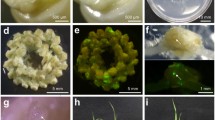Abstract
We report the generation of transgenic barley plants via PEG-mediated direct DNA uptake to protoplasts. Protoplasts isolated from embryogenic cell suspensions of barley (Hordeum vulgare L. cv ‘Igri’) were PEG-treated in a solution containing a plasmid which contained the neomycin phosphotransferase (NPT II) gene under the control of the rice actin promoter and the nos terminator. Colonies developing from the treated protoplasts were incubated in liquid medium containing the selective antibiotic G418. Surviving calli were subsequently transferred to solid media containing G418, on which embryogenic calli developed. These calli gave rise to albino and green shoots on antibiotic-free regeneration medium. NPT II ELISA revealed that approximately half of the morphogenic calli expressed the foreign gene. In total, 12 plantlets derived from NPT-positive calli survived transfer to soil. Southern hybridization analysis confirmed the stable transformation of these plants. However, the foreign gene seemed to be inactivated in plants from one transgenic line. Most of the transgenic plants set seed, and the foreign gene was transmitted and expressed in their progenies, which was ascertained by Southern hybridization and NPT II ELISA.
Similar content being viewed by others
References
Barcelo P, Hagel C, Becker D, Martin A, Lörz H (1994) Transgenic cereal (tritordeum) plants obtained at high efficiency by micro-projectile bombardment of inflorescence tissue. Plant J 5: 583–592
Borchardt A, Hodal L, Palmgren G, Mattsson O, Okkels FT (1992) DNA methylation is involved in maintenance of an unusual expression pattern of an introduced gene. Plant Physiol 99:409–414
Christou P, Ford T, Kofrom M (1991) Production of transgenic rice (Oryza sativa L.) plants from agronomically important indica and japonica varieties via electric discharge particle acceleration of exogenous DNA into immature zygotic embryos. Bio/Technol 9:957–962
Funatsuki H, Kihara M (1994) Influence of primary callus induction conditions on the establishment of barley cell suspensions yielding regenerable protoplasts. Plant Cell Rep 13:551–555
Funatsuki H, Lazzeri PA, Lörz H (1992) Use of feeder cells to improve barley protoplast culture and plant regeneration. Plant Sci 85:251–254
Funatsuki H, Müller E, Lazzeri PA, Lörz H (1994) Production of somatic hybrid calli between Hordeum vulgare L. and Hordeum bulbosum L. J Plant Physiol 144:251–254
Golds TJ, Babczinsky J, Mordhorst AP, Koop HU (1994) Protoplast preparation without centrifugation: plant regeneration of barley (Hordeum vulgare L.). Plant Cell Rep 13:188–192
Ghosh Biswas GC, Burkhanot PK, Wünn J, Klöti A, Potrykus I (1994) Fertile indica rice plants regenerated from protoplasts isolated from scuteller tissue of immature embryos. Plant Cell Rep 13:528–532
Gupta HS, Pattanayak A (1993) Plant regeneration from mesophyll protoplasts of rice (Oryza sativa L.). Bio/Technol 11:90–94
Hagio T, Hirabayashi T, Machii H, Tomotsune H (1995) Production of fertile transgenic barley (Hordeum vulgare L.) plants using the hygromycin-resistance marker. Plant Cell Rep 14:329–334
Jähne A, Lazzeri PA, Lörz H (1991) Regeneration of fertile plants from protoplasts derived from embryogenic cell suspensions of barley (Hordeum vulgare L.). Plant Cell Rep 10:1–6
Jähne A, Becker D, Brettschneider R, Lörz H (1994) Regeneration of transgenic, microspore-derived, fertile barley. Theor Appl Genet 89:525–533
Kihara M, Funatsuki H (1994) Fertile plant regeneration from barley (Hordeum vulgare L.) protoplasts isolated from long-term suspension culture. Breed Sci 44:157–160
Lazzeri PA, Brettschneider R, Lührs R, Lörz H (1991) Stable transformation of barley via PEG-induced direct DNA uptake into protoplasts. Theor Appl Genet 81:437–444
Lazzeri PA, Jähne A, Lörz H (1992) Culture, regeneration and transformation of barley protoplasts. In: Lindsey K (ed) Plant tissue culture manual part B10: fundamentals and applications. Kluwer Academic, Dordrecht, pp 1–11
Linn F, Heidmann I, Bussmann K, Saedler H, Meyer P (1990) Epigenetic changes in the expression of the maize A1 gene in Petuna hybrida: role of numbers of integrated gene copies and state of methylation. Mol Gen Genet 222:329–336
Lörz H, Lazzeri PA (1992) In vitro regeneration and genetic transformation of barley. In: Munck L (ed) Barley genetics VI, vol 2. Munksgaard International, Copenhagen, pp 807–815
Lörz H, Gobel E, Brown P (1988) Advances in tissue culture and progress towards genetic transformation of cereals. Plant Breed 100:1–25
Marsan PA, Lupotto E, Locatelli F, Qiao YM, Cattaneo M (1993) Analysis of stable events of transformation in wheat via PEG medited DNA uptake into protoplasts. Plant Sci 93:85–94
McElroy D, Zhang W, Wu R (1990) Isolation of an efficient actin promoter for use in rice transformation. Plant Cell 2:163–171
Potrykus I (1990) Gene transfer to cereals: an assesssment. Bio/Technol 8:535–542
Ritala A, Aspergren K, Kurten U, Salmenkallio-Marttila M, Mannonen L, Hannus R, Kauppinen V, Teeri TH, Enari TM (1994) Fertile transgenic barley by particle bombardment of immature embryos. Plant Mol Biol 24:317–325
Sambrook J, Fritsch EF, Maniatis T (1989) Molecular cloning: a laboratory manual, 2nd edn. Cold Spring Harbor Laboratory, Cold Spring Harbor, New York
Töpfer R, Schell J, Steinbiss HH (1988) Versatile cloning vectors for transient gene expression and direct gene transfer in plant cells. Nucleic Acids Res 16:8725
Varadarajan GS, Prakash CS (1991) A rapid and efficient method for the extraction of total DNA from the sweet potato and its related species. Plant Mol Biol Rep 9:6–12
Vasil IK (1994) Molecular improvements of cereals. Plant Mol Biol 25:925–937
Wan Y, Lemaux PG (1994) Generation of large numbers of independently transformed fertile barley plants. Plant Physiol 104:37–48
Wasseneger M, Heimes S, Riedel L, Sänger HL (1994) RNA-directed de novo methylation of genomic sequenses in plants. Cell 76:567–576
Author information
Authors and Affiliations
Additional information
Communicated by K. Tsunewaki
Rights and permissions
About this article
Cite this article
Funatsuki, H., Kuroda, H., Kihara, M. et al. Fertile transgenic barley generated by direct DNA transfer to protoplasts. Theoret. Appl. Genetics 91, 707–712 (1995). https://doi.org/10.1007/BF00220947
Received:
Accepted:
Issue Date:
DOI: https://doi.org/10.1007/BF00220947




